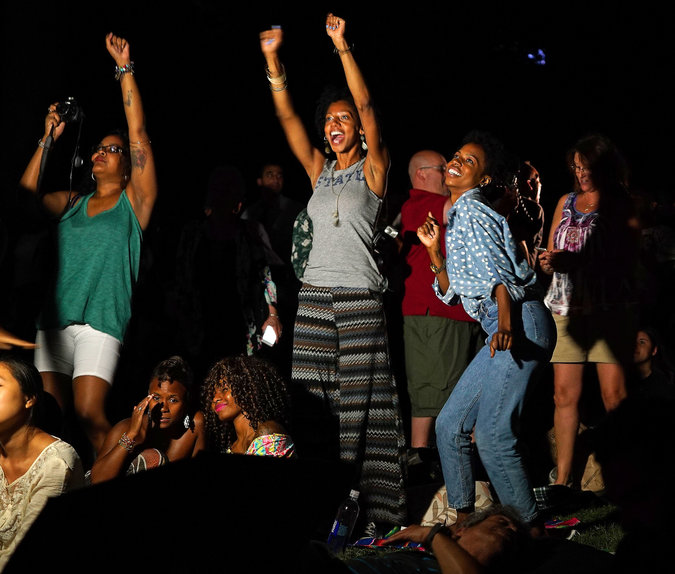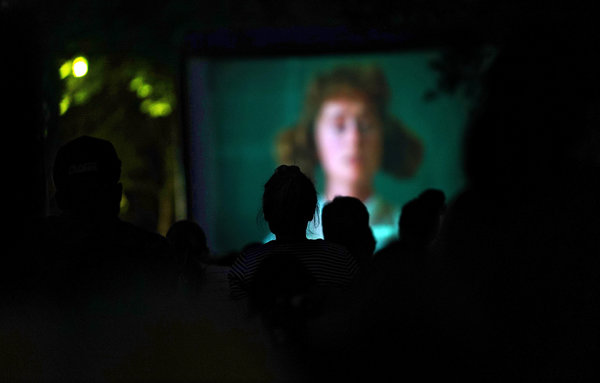| The Show | Creative Team | Productions | Sights/Sounds | Reviews | Foundation | Extras | FFF.Org |
Home > Current Buzz > A ‘Fame' Screening in Central Park Draws Alumni Extras
...........................................................................................................
A ‘Fame’ Screening in Central Park Draws Alumni Extras
By RALPH BLUMENTHAL
AUG. 26, 2015

An impromptu dance at the finale of a showing of “Fame” on Tuesday night.
Credit Nicole Bengiveno/The New York Times
For two and a half hours in Central Park on Tuesday night, Leslie Cohn wasn’t the manager of a Twist Frozen Yogurt shop in Westwood, N.J., a 53-year-old single mom with two grown sons.
She was a teenager again, a star-struck would-be operatic diva at the Fiorello H. LaGuardia High School of Music & Art and Performing Arts, with a foot practically in Hollywood. She was on the big screen, a chorister in the 1980 movie “Fame,” the high school talent musical that, like its theme song — with the memorable refrain “I’m gonna live forever” — spawned an industry of television and stage versions.
Thirty-five years after their own first brush with fame, dozens of former students who performed as mostly anonymous extras in the movie thronged a showing in the park to cheer their teenage selves and sing along with the movie’s Oscar-winning soundtrack and title anthem.
They screeched and wildly embraced as they recognized long-ago faces. “It takes me back to the first day,” said Anthony Evans, remembering the bus waiting outside the Music & Art castle in Harlem to carry students to the film auditions in Times Square. He went on to write the song “Never Alone” for the movie and to make a career in gospel music.

The screening on Tuesday prompted an unofficial reunion of LaGuardia
alumni, including Ladd Boris. Credit Nicole Bengiveno/The New York Times
The movie is “a moving yearbook,” said Loris Diran, a former drama major who became a fashion designer after apprenticing with Versace and Chanel. He was wearing himself: gray and black camouflage blazer over white V-neck T-shirt, skinny gray corduroys and loafers.
Reuniting for the showing was “a flash mob thing,” said Ladd Boris, who sang in the Metropolitan Opera chorus before briefly entering the funeral business in Florida and then returning to New York to restart a career on the musical stage.
He had no sooner seen the announcement of the screening two weeks ago, he said, than he “made an Evite, created an event” and blasted it out to “850 of my closest friends.” LaGuardia’s alumni association helped mobilize the several hundred graduates who turned up amid a crowd officially put at 5,900.
Named for the actor Alan Ladd, Mr. Boris, who had used his bar mitzvah money to buy a subscription to the Met, recalled his years at LaGuardia as “a magical time.”
“We would sing a Walter Hawkins gospel song one minute and follow it with the singing of ‘In sempiterna saecula, amen’ from Rossini’s Stabat Mater,” he said. “No one batted an eye or thought this was strange. This was who we were. We were black, white, Asian, Latino, gay, straight, Jewish, Christian, Buddhist, rich, middle-class, poor.” Outside lay a divided America, he went on, but “we were brothers and sisters who shared a common joy of making music, art, dance and theater.”
But for every Gregory Buchalter, who snared a violin cameo in the movie and became a cover conductor at the Metropolitan Opera, and Leo Colon, now music director for Vanessa Williams, others became teachers, ministers and social workers. Some emerged disappointed that their road to stardom ended then and there. The experience, said Sari Henry, now a photojournalist, “pretty much ruined it for me.”
But “a lot of us funded college with that money,” Mr. Diran said. The students who appeared in the movie still get residuals; one former extra, Christine Carabetta, said she most recently got a check for $14.86, after taxes.
The 8 p.m. screening, held in a field between the Sheep Meadow and the 72nd Street Cross Drive, was part of the Central Park Conservancy Film Festival, which began in 2003 to celebrate the 150th anniversary of Central Park. This year, the conservancy, the private nonprofit group that manages the park under a city contract, is showing films from 1980, the year it was founded. After “Fame” and “The Blues Brothers,” the week’s remaining screenings, starting Thursday, are “Airplane!,” followed Friday and Saturday by “Raging Bull” and “Superman II.”

At the screening of “Fame." Credit Nicole Bengiveno/The New York Times
Long before “Glee” and reality entertainment, “Fame” trafficked in the genre of “ordinary people becoming stars — it taps into that, the idea that you can be discovered,” said David Schwartz, chief curator of the Museum of the Moving Image, a partner in the film series. Set in a gritty 1970s New York, “Fame” was notable for another reason, Mr. Schwartz said: “Most of the other great high school movies are suburban.”
Directed by Alan Parker, who also made “Midnight Express” (1978) and “Mississippi Burning” (1988), “Fame” starred Anne Meara as a tenderhearted disciplinarian, Irene Cara (who also was a writer of the 1983 Oscar-winning title song “Flashdance ... What a Feeling”) as a student, Richard Belzer as a comedy club M.C., and some actual LaGuardia faculty members.
Its backdrop was the 1894 Romanesque schoolhouse at 120 West 46th Street that Performing Arts had occupied since 1948. Merged on paper in 1961 with the High School of Music & Art on 135th Street and Convent Avenue, the combined school, named for the former mayor who founded Music & Art in 1936, was consolidated in new quarters on Amsterdam Avenue, behind Lincoln Center, in 1984. Alumni include Al Pacino, Robert De Niro, Liza Minnelli and Eartha Kitt.
But “Fame” was not filmed inside Performing Arts’s picturesque haunts. School authorities balked at raw parts of the script. Instead, the Board of Education provided other buildings for interiors, and the Episcopal Church of St. Mary the Virgin, across 46th Street, doubled for entrances and exits.
The film was conceived by David De Silva, a theatrical agent. “My idea was to follow a group of acting, dancing kids,” he said. The initial title was “Hot Lunch.” But as Mr. De Silva recalled in a discussion before the screening: “We heard from MGM that we couldn’t use the title. There was a pornographic movie — and its star was Al Parker.”
He thought “Fame” sounded grandiose, but the filmmakers went with it. “It really changed the culture,” Mr. De Silva, 79, said in an interview. Public arts education got a boost. The film inspired the television series of the same title, which began on NBC in 1982, and a stage musical that played around the country and ran off Broadway in 2003 and 2004.
A Hollywood remake in 2009 was “a disaster,” Mr. De Silva said. “I was not involved.” But his hourlong musical “Fame Jr.” gets about 100 productions a year in schools around the country.
Ms. Cohn, the yogurt store manager, still cherishes her scenes and uncredited role off camera as “assistant to the assistant director/producer.” “We worked the auditions,” she said, “shuffling people in and out and of the audition rooms and taking Polaroids of the auditioners, reading parts with people.”
Friends laugh and tell her, she said, “You were a gofer, Leslie.”
“Yeah?” is her comeback. “When was the last time you were a gofer on a major motion picture when you were still 16?”
